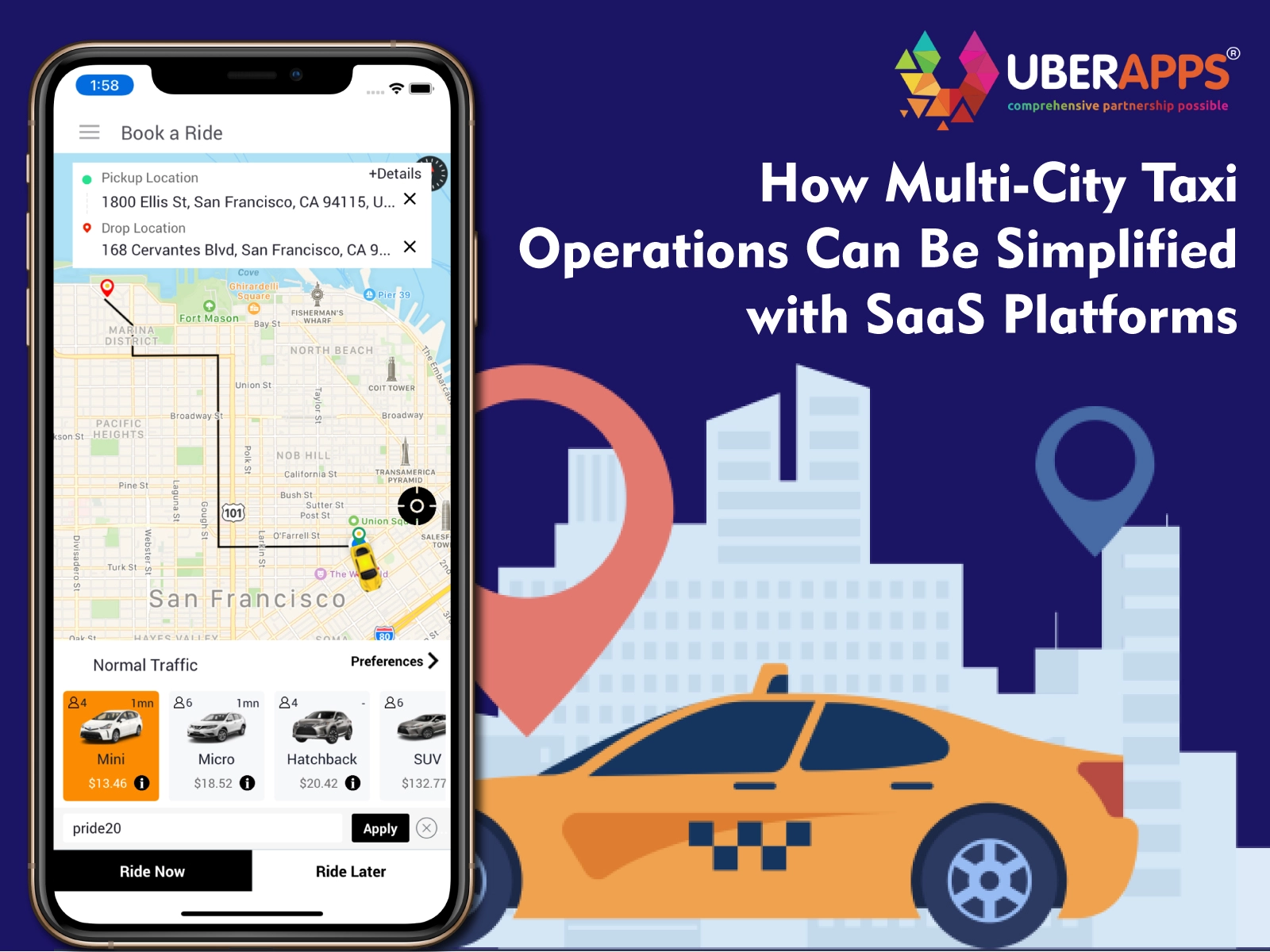
How Multi-City Taxi Operations Can Be Simplified with SaaS Platforms
Expanding a taxi business across multiple cities is no small feat. Entrepreneurs face challenges in scaling, managing drivers, standardizing operations, and ensuring seamless customer experiences across diverse geographies. This is where SaaS-based taxi apps come into play. Platforms like UberApps offer flexible, cloud-powered solutions that simplify multi-city taxi operations without heavy infrastructure costs.
In this guide, we’ll explore how SaaS platforms can revolutionize taxi booking apps, streamline ride-hailing app features, and enable in-app payments for taxi apps, all while reducing operational complexity for local entrepreneurs.
Expanding a taxi business into multiple cities is challenging due to varying regulations, customer expectations, and fleet management. However, SaaS-based taxi apps simplify these challenges with cloud-powered solutions. Platforms like UberApps offer centralized dashboards, multi-currency payments, driver optimization, and scalable infrastructure to make multi-city operations seamless. Entrepreneurs can launch faster, reduce costs, and provide passengers with consistent, high-quality service. With ride-hailing app features such as one-tap booking, GPS tracking, secure in-app payments, and real-time analytics, scaling across cities becomes efficient and cost-effective. Unlike traditional taxi app development, SaaS platforms require no heavy upfront investment and are designed for scalability. The future of taxi businesses lies in SaaS-powered innovation, enabling entrepreneurs to focus on growth while technology manages complexity.
Why Multi-City Taxi Operations Are Challenging
1 Diverse Regulations and Compliance
Each city has unique transportation laws.
- Licensing, insurance, and local permits add complexity.
Key takeaway: Without a unified system, managing compliance becomes costly and time-consuming.
2 Fleet and Driver Management
Coordinating thousands of drivers across different cities is difficult.
- Manual monitoring often leads to inefficiency.
3Customer Expectations
Passengers demand real-time tracking, multiple payment options, and consistent service quality.
- Any operational delay can damage trust.
What Is a SaaS-Based Taxi App?
A SaaS-based taxi app is a cloud-hosted taxi booking solution offered on a subscription model. Instead of building custom software from scratch, entrepreneurs can launch and scale with pre-built yet customizable features.
Benefits of SaaS Taxi Solutions
- Lower costs compared to traditional taxi app development.
- Scalability across multiple cities without extra servers.
- Automatic updates and new feature rollouts.
How SaaS Platforms Simplify Multi-City Taxi Operations
1 Centralized Management Dashboard
- Unified control over multiple cities.
- View performance, earnings, and driver data in real time.
Bold takeaway: A single dashboard reduces admin overhead and ensures consistency.
2 Multi-Currency and Multi-Language Support
- Supports local currencies for smooth in-app payments for taxi apps.
- Adapts to regional languages for customer convenience.
3 Location-Based Customization
- Define city-specific pricing models.
- Configure surge pricing and discounts per location.
4 Driver and Fleet Optimization
- AI-based allocation reduces wait times.
- Monitor driver ratings and performance across cities.
Must-Have Ride-Hailing App Features in SaaS Platforms
Passenger App Features
- One-tap booking
- Real-time GPS tracking
- Multiple payment options
- Fare estimates and receipts
Driver App Features
- Smart job allocation
- Earnings reports
- In-app navigation
- SOS/emergency button
Admin Panel Features
- Analytics dashboard
- Automated billing and payouts
- City-wise performance tracking
- Fraud detection tools
In-App Payments for Taxi Apps
Secure Payment Gateways
SaaS platforms integrate with gateways like Stripe, PayPal, or Razorpay.
- Enables cashless transactions, reducing driver cash handling.
Multiple Payment Options
- Credit/Debit cards
- Digital wallets
- Net banking
- Cash on delivery (if preferred locally)
Bold takeaway: Flexible payment systems enhance passenger trust and loyalty.
SaaS vs Traditional Taxi App Development
Traditional Development
- Requires months of coding.
- High upfront investment.
- Costly to scale into multiple cities.
SaaS Taxi Platforms
- Subscription-based, pay-as-you-go model.
- Ready-to-launch within weeks.
- Built for multi-city scalability.
Case Example: UberApps for Multi-City Taxi Startups
UberApps provides a scalable SaaS taxi solution tailored for entrepreneurs. Whether you want to expand from one city to ten, UberApps ensures:
- Seamless deployment across multiple locations.
- Consistent passenger experience.
- Easy integration with local payment methods.
Steps to Launch Multi-City Taxi Operations with SaaS
- Choose the right SaaS taxi app provider (UberApps recommended).
- Customize branding with your logo, theme, and city-specific pricing.
- Onboard drivers and vehicles with verification tools.
- Integrate local payment gateways for smooth transactions.
- Launch city by city, monitoring performance through the admin dashboard.
Future of Multi-City Taxi Businesses with SaaS
The future of multi-city taxi operations is inseparable from technology. As mobility ecosystems evolve, SaaS platforms are integrating advanced tools like AI, IoT, and blockchain to redefine efficiency, security, and scalability. Entrepreneurs who adopt these innovations early will position their taxi businesses as leaders in the next wave of urban mobility.
AI-Powered Operations: Smarter Multi-City Dispatch
Artificial Intelligence (AI) is transforming how SaaS-based taxi apps manage city-wide demand and supply. For taxi operators expanding into multiple cities, AI ensures operations are not only streamlined but also highly adaptive.
Predictive Demand Forecasting
AI algorithms analyze historical ride data, weather patterns, and local events to predict peak demand zones in each city.
Example: AI can forecast a surge near stadiums during sports events or downtown during office hours.
Benefit: Businesses can position drivers proactively, reducing waiting times and improving customer satisfaction.
Dynamic Pricing and Surge Optimization
- AI automates pricing strategies across cities.
- Real-time demand–supply gaps trigger surge pricing automatically.
- City-specific cost factors (fuel, tolls, or congestion zones) can be adjusted dynamically.
Key takeaway: AI empowers taxi operators to maximize revenue while ensuring passengers get reliable rides during peak hours.
IoT and Connected Vehicles: Real-Time Insights for Multi-City Fleets
The Internet of Things (IoT) is unlocking real-time connectivity between vehicles, drivers, and administrators. In a SaaS taxi ecosystem, IoT ensures fleet management is smarter and safer, even when operating across multiple cities.
Fleet Health Monitoring
- IoT-enabled sensors track vehicle health in real time.
- Alerts for oil changes, tire wear, or engine performance prevent unexpected breakdowns.
- Predictive maintenance reduces downtime and keeps more cars on the road.
Route Optimization
- GPS-enabled IoT devices work with SaaS platforms to optimize routes.
- Drivers receive real-time traffic updates and alternative paths.
- Multi-city operators can cut fuel costs and improve trip efficiency.
Passenger Safety Enhancements
- SOS alerts trigger real-time tracking for admin teams.
- Telematics data ensures drivers follow safe driving patterns.
Bold takeaway: IoT ensures that managing thousands of cars across multiple cities is no longer overwhelming—it’s proactive and data-driven.
Blockchain for Payments: Transparent and Borderless Transactions
Payment complexity is a major hurdle in multi-city taxi operations. With in-app payments for taxi apps becoming the norm, blockchain introduces trust, speed, and security into the financial ecosystem.
Fraud-Proof Transactions
- Blockchain ensures tamper-proof ride records and receipts.
- Each ride transaction is securely recorded in a decentralized ledger.
- Disputes over fares or driver payments are minimized.
Multi-Currency and Cross-Border Support
- For businesses operating in multiple countries, blockchain enables seamless international payments.
- Supports crypto and stablecoins as alternatives to traditional banking.
- Reduces conversion fees when operating across regions with different currencies.
Faster Settlements
Unlike traditional banking, which may take days, blockchain processes instant settlements between passengers, drivers, and operators.
Bold takeaway: Blockchain-powered SaaS taxi apps deliver the transparency and reliability modern users expect in digital mobility.
Conclusion
Running a taxi business across multiple cities doesn’t have to be overwhelming. Traditional taxi app development often locks entrepreneurs into long timelines and high costs, while SaaS platforms like UberApps bring flexibility, speed, and affordability.
With features like centralized dashboards, multi-currency payments, driver optimization, and AI-based demand prediction, SaaS-based taxi apps empower entrepreneurs to focus on growth rather than infrastructure. Multi-city expansion becomes manageable when technology handles the heavy lifting—leaving you free to focus on scaling your brand, improving passenger satisfaction, and staying ahead of competitors.
If you’re planning to expand your taxi business across new cities, a SaaS taxi platform is the cost-effective, future-ready solution. UberApps provides all the tools you need to launch, manage, and grow seamlessly—without reinventing the wheel.
The future of taxi booking apps lies in SaaS-powered innovation, and the businesses that adopt these solutions today will become tomorrow’s leaders in urban mobility.
FAQS
1. What is a SaaS taxi app and how is it different from traditional development?
A SaaS taxi app is a cloud-based, subscription model platform that offers pre-built features for faster launch and easier scaling compared to costly custom development.
2. Can SaaS-based taxi apps handle multi-currency payments?
Yes. They support multiple payment gateways and currencies, making it easier for businesses to operate across different cities and countries.
3. Is it possible to customize SaaS taxi apps to match my brand?
Absolutely. You can customize the app’s theme, logo, pricing models, and even city-specific features.
4. How secure are in-app payments for taxi apps?
SaaS platforms integrate with trusted payment gateways that use encryption and fraud detection, ensuring passenger safety and transaction security.
5. Can SaaS platforms help with regulatory compliance in multiple cities?
Yes, they provide tools to manage driver verification, documents, and reporting to help meet city-specific regulations.
Author's Bio

Vinay Jain is the Founder of UBERApps and brings over 10 years of entrepreneurial experience. His focus revolves around software & business development and customer satisfaction.

